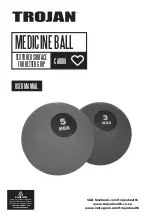
16
Section 1 - Safety Information
1.3 Hose Safety
General
Ultra-High Pressure hoses are tough, but not in-
vincible. They require proper care and handling
to achieve the normal service life of 300 - 600
hours. If the hoses are abused, the service life
will be much shorter.
Stretched or abused hose can fail prematurely
and unexpectedly, which could cause injury to
personnel. Hoses that have been exposed to
excessive stretching or kinks should be removed
from service and discarded.
Hoses Present Tripping Hazards
Be careful to layout the hoses to reduce risk of
entanglement and tripping.
Check Connections
Check the condition of the connection threads
prior to connecting any fittings or hoses. Use an
anti-seize compound on all fittings and hoses
to prevent “galling,” as galling will destroy the
threads, fittings and/or hose ends.
Tighten Connections
Properly tighten all high pressure connections.
Usually, snug plus a 15% tightening will properly
seal connections.
Take Proper Care of Your Hose
A) Protect the hose from contact with sharp
objects, abrasive surfaces and foot or wheel
traffic.
B) Never subject Ultra-High Pressure hose to a
tight radius (less than 30” (.8 m) or pull on a
coiled hose. Always make sure the hoses are
straight with no coils before pulling on the hose
to deploy it.
C) Never pull hard on an Ultra-High Pressure hose
or expose the hose to heavy loads like drag-
ging equipment or deploying long lengths of
hose. This can stretch the hose and weaken
it. Never pull more than 25 feet of hose by a
coupler or fitting. Always move long lengths
of hose by the hose itself to keep the strain
off the fittings.
D) When using a tractor or a hog tool, always op-
erate the equipment well within the maximum
distance to avoid straining or damaging hoses.
Check Burst Rating
Do not use an Ultra-High Pressure hose that does
not have a listed burst rating or with a burst rating
of less than 60,000 PSI (4,137 BAR).
Retire Hose from Service if:
A) Cover is damaged and reinforcing wires are
exposed to rust and corrosion.
B) Cover is loose and/or has blisters or bulges.
C) Hose has been crushed or kinked.
D) End fitting shows evidence of damage, slippage
or leakage.
E) Hose has been exposed to pressures of 2 times
the operating pressure.
F) Hose has been stressed or stretched.
Check Dump Valve Water Hose
Any hose used for returning dumped water back
to the pump or vacuum line must have a large
enough diameter and psi strength so that poten-
tially dangerous release pressure is allowed full
flow and release pressure is contained safely. Keep
hose in good condition.
1.4 High Pressure Fitting Safety
Fitting Ratings
Use high pressure fittings with a rating of 60,000
psi (4137 BAR.)
Check Fittings
Do not use fittings that have been cross threaded
or have damaged threads.
Fitting Connections
Use anti-seize compound on all
hose and fitting
connections to prevent galling. Do NOT apply
anti-seize to the seating area of any connections.
Summary of Contents for HT1000SR
Page 2: ...2...
Page 6: ...6 NOTES...
Page 8: ...8 NOTES...
Page 18: ...18 NOTES...
Page 34: ...34 NOTES...
Page 76: ...76 NOTES...
Page 77: ...77 Appendix 3 Tools Spare Parts Mobile Tool System...
Page 80: ...80 NOTES...
Page 86: ...86 NOTES...
Page 89: ......
















































